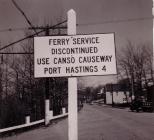15
DEDICATED VISIONARY - 1953- Leonard O'Neil, Mayor of Mulgrave, gathered together businessmen and politicians from Antigonish, Guysborough, Inverness, and Richmond Counties to form the Four County Industrial Development Association whose main objective was to bring a pulp and paper mill to the Strait of Canso area. Factors to Consider When Choosing a Mill Site - WOOD, POWER, WATER (24 Million gallons a day),LOCATION (Deep sea and rail shipping available), ON or NEAR PROVINCIAL HIGHWAY, FINANCING AND MANPOWER.
17
LAST CROSSING - The crew of the Scotia II train ferry received their letters stating their services were no longer needed as of May 14th, 1955. A group picture was taken before the last run across the Strait of Canso between Mulgrave and Point Tupper was made.Point Tupper was particularly hard hit as the industry that eventually came to the Strait of Canso area starting in 1959 located in their back yard, and eventually cause their families to be relocated in the 1980's.
Population in 1951 for Port Hawkesbury was 1,034, Mulgrave - 1,212 and Point Tupper -394.
By 2001, Port Hawkesbury was 3701, Mulgrave- 904 and Point Tupper - 12.
20
FORCED TO LEAVE AREA - 1955- Workers like Francis O'Neil who had worked on the Scotia train ferry between Mulgrave and Point Tupper did have to leave his wife and children behind in Mulgrave and go to work at the other end of the province of Nova Scotia. Many others were forced to do the same while many left the community altogether.22
IMPACT ON MULGRAVE BLEAK - Under the newspaper headline, "Progress Forges Ahead, The Old Bows to the New" in May 1955, this picture was beside the one of the last run of the train ferry across the Strait of Canso and the railway vice president at the ribbon cutting ceremony of the first official train to cross the Canso Causeway.The future looked bleak for the families in these small communites who had relied on the ferries and railroad for their livelihood for over fifty years.
23
Port Hastings village looking north towards Canal and Causeway1958
Port Hastings, Inverness County, Nova Scotia, Canada

24
JOBS IN TOURISM AND TOLL BOOTHS1955- 1959 - New jobs were created at the Canso Canal and Toll Booths on the Canso Causeway.
Formerly a small peaceful village, Port Hastings suddenly became a focal point in the Trans Canada Highway.
There was an increase in tourism traffic and the Tourist Bureau which had been at the car ferry dock in Port Hawkesbury was moved to Port Hastings. It has been expanded over the years but still welcomes thousands of visitors to Cape Breton Island in 2005, fifty years after the opening of the Canso Causeway.
26
LADIES CHURCH GROUP MEET - In 1958, the ladies of St. David's United Church in Port Hastings which stands as a welcoming beacon to everyone driving onto Cape Breton Island, were carrying on as usual. The W.M.S. or Women's Missionay Society were having their meeting on the front lawn of the church manse on Brown Street on the hill above the church.Cape Porcupine from which a little more than 10 million tons of rock were quarried to build the deepest man made causeway in the world,the Canso Causeway, can be seen on the mainland side of the Strait of Canso.
27
Community looking north from Cape Porcupine1953
Auld's Cove, Guysborough County, Nova Scotia, Canada






